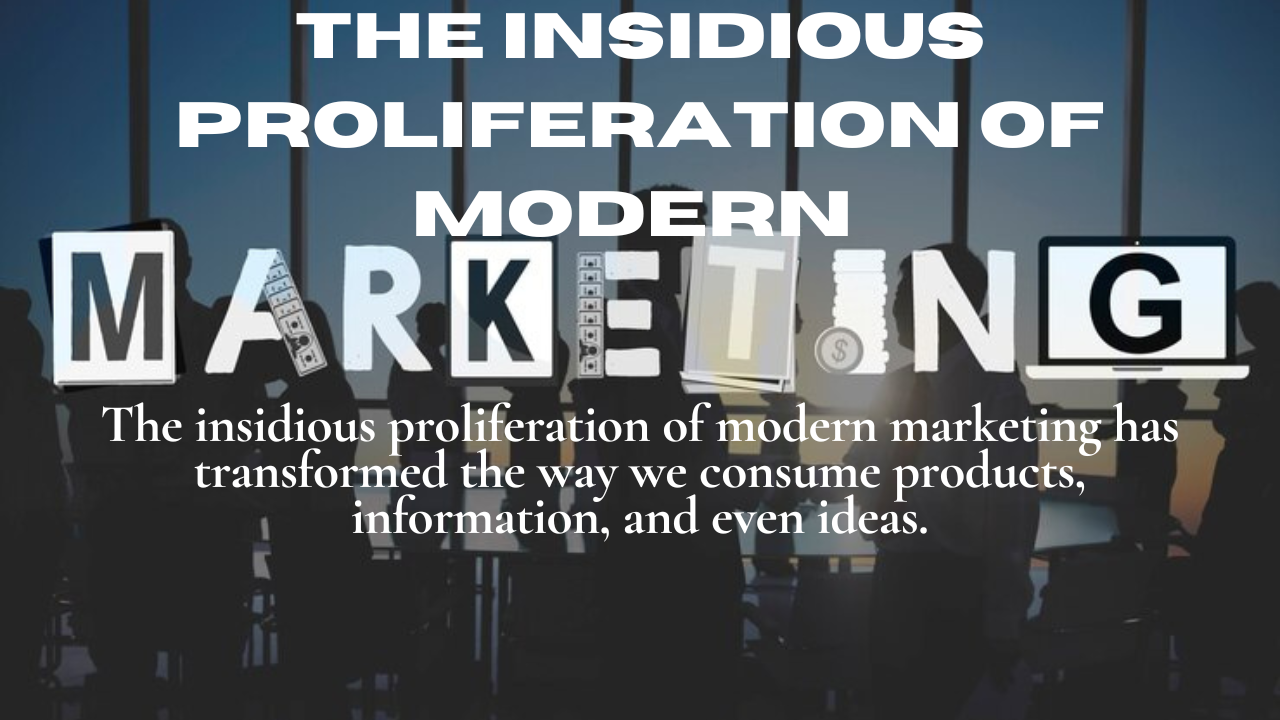In today’s hyper-connected world, marketing is everywhere. From the moment we wake up and check our phones to when we go to bed, advertising and marketing messages surround us. What was once confined to billboards, TV commercials, and newspaper ads has now infiltrated every aspect of our lives. This constant stream of marketing has led to what many describe as the insidious proliferation of modern marketing. It’s no longer just about selling products—it’s about influencing our thoughts, behaviors, and even our identities.
The Evolution of Marketing: From Traditional to Modern
Marketing has evolved dramatically over the past century. Traditional marketing, which relied on print, radio, and television ads, was more straightforward. Brands paid for space or airtime, and consumers chose whether or not to engage with the ads. The boundaries were clear, and the advertising landscape was relatively easy to navigate.
Fast forward to the digital age, and marketing has exploded into a complex, multifaceted industry that touches every aspect of our lives. The rise of the internet, smartphones, and social media has created endless opportunities for brands to reach consumers. The problem? This new era of marketing is often subtle, invasive, and inescapable.
How Modern Marketing Permeates Our Lives
Today, marketing isn’t just something we see—it’s something we experience. It’s everywhere, and its proliferation is difficult to escape. Here’s how modern marketing has wormed its way into nearly every facet of our daily lives:
1. Social Media and Influencer Marketing
One of the most potent tools in modern marketing’s arsenal is social media. Platforms like Instagram, Facebook, TikTok, and YouTube have become breeding grounds for advertising content, often disguised as genuine interactions or personal endorsements. Influencers, individuals who have built large followings, are paid by brands to promote products to their audiences.
What makes influencer marketing so effective—and so insidious—is that it feels authentic. When a person you follow and trust recommends a product, it doesn’t feel like an ad. However, behind the scenes, many influencers are receiving significant compensation to push these products, blurring the line between genuine recommendation and paid promotion.
2. Data-Driven Personalization
The most disturbing aspect of modern marketing might be its ability to personalize ads based on our behaviors. Every click, every search query, every ‘like’ on social media is tracked, collected, and analyzed by algorithms to build detailed consumer profiles. Marketers then use this data to target ads directly at us, knowing exactly what we might be interested in and when we’re most likely to engage.
This hyper-personalized marketing feels almost intrusive, as if companies know more about our desires and habits than we do ourselves. Ads are now tailor-made for each individual, delivered at the exact moment we’re most vulnerable to their message, making it harder to resist buying.
3. Content Marketing and Native Advertising
Gone are the days of blatant, in-your-face advertisements. Modern marketing has become more subtle through content marketing and native advertising. Content marketing involves creating valuable, engaging content that draws in consumers without explicitly promoting a product. Think of blog posts, podcasts, and how-to videos that are designed to inform or entertain but are funded by brands looking to increase their reach.
Native advertising, on the other hand, blends in with the surrounding content, making it harder to distinguish from genuine, unbiased information. This could be a sponsored article on your favorite news website or a promoted post in your social media feed. Because it’s designed to look like regular content, consumers are often unaware they’re being marketed to.
4. The Rise of Subscription Services and Freemium Models
Many companies now use subscription services and freemium models as a way to embed their marketing into our daily lives. While these models offer value upfront, the true cost often lies in constant upselling and exposure to premium features. Services like Spotify and YouTube bombard users with ads unless they subscribe to a premium plan, making it almost impossible to avoid marketing without paying.
Moreover, many of these services track user behavior to deliver even more targeted ads or suggestions, contributing to the broader marketing ecosystem.
5. The Internet of Things (IoT) and Smart Devices
Smart devices and the Internet of Things (IoT) are another frontier in modern marketing. From smart speakers like Amazon’s Alexa to fitness trackers and smart refrigerators, these devices collect a wealth of data about our lives and habits. This data is then used to deliver highly personalized advertising.
For example, your smart fridge might suggest products you’ve run out of, and your fitness tracker might recommend a specific brand of running shoes based on your recent activity. As more of our everyday objects become connected, we can expect marketing to infiltrate even deeper into our personal spaces.
The Psychological Impact of Constant Marketing
The insidious proliferation of modern marketing isn’t just about selling products—it’s about influencing how we think and feel. The constant barrage of ads, personalized content, and influencer promotions can have profound psychological effects. The insidious proliferation of modern marketing has transformed the way we consume products, information, and even ideas.
1. Consumer Fatigue
With ads appearing in almost every digital space we navigate, from social media to news sites, many consumers are experiencing what’s known as “ad fatigue.” This refers to the mental exhaustion and frustration that comes with seeing the same ads over and over again. This fatigue can lead to a negative perception of brands, as people become overwhelmed by the sheer volume of marketing messages they encounter.
2. Manipulating Desires and Self-Perception
Modern marketing is highly adept at creating desires and needs that didn’t exist before. It plays on our insecurities and aspirations, making us believe that happiness or success is tied to the products we buy. Social media platforms, in particular, contribute to this by constantly showing us curated, idealized versions of life that make us feel inadequate by comparison.
Influencers and brands promote lifestyles that often seem unattainable without the right products, subtly manipulating our self-perception and pushing us towards consumption as a solution to our insecurities.
3. The Blurring Line Between Reality and Advertising
The rise of influencer marketing and native advertising has blurred the lines between reality and advertising. Consumers are often unaware that the content they’re engaging with is an ad, which erodes trustWhen advertisers disguise ads as genuine recommendations or organic content, it becomes difficult to differentiate between what’s real and what’s promotional.
Is There an Escape from Modern Marketing?
As marketing continues to evolve, it’s becoming increasingly difficult to escape its reach. Ad blockers and privacy tools can help reduce exposure, but they are not foolproof. Social media platforms, websites, and apps have adapted by integrating ads more seamlessly into content, making them harder to block or avoid.
At the same time, there’s a growing movement of consumers who are pushing back against the dominance of marketing in their lives. More people are opting out of social media, avoiding sites that use native advertising, or choosing to pay for premium services to avoid being bombarded with ads. Yet, in a world where data is currency, and marketing is omnipresent, true freedom from it may be a near-impossible goal.
Conclusion: The Perils of Modern Marketing’s Reach
The insidious proliferation of modern marketing has transformed the way we consume products, information, and even ideas. It’s no longer confined to billboards and TV screens—now it fills our social media feeds, integrates with our favorite content, and personalizes itself to our every move.
The psychological impact of this constant exposure can be overwhelming, manipulating our desires and shaping our perceptions in ways we may not even realize.
As consumers, it’s crucial to be aware of the tactics marketers use to influence our behavior and to question the content we engage with. While marketing is a necessary part of the economy, its increasingly invasive presence in our lives calls for greater scrutiny and a deeper understanding of how it affects us.











